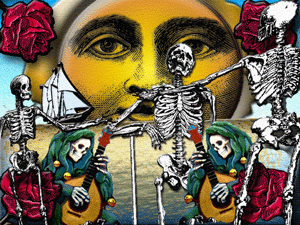In the modern world of marketing, it’s less “what you say” and more “what you do” that counts, a theme that runs through my latest book, High Impact Marketing That Gets Results.
This mantra has led organisations and companies to actively use customer collaboration as a marketing strategy.
Think open-source software, smartphone apps and customer reviews on TripAdvisor and Amazon. Consumers today are active – not passive – participants in just about every link of the value chain.
Thinking of consumers not as units of economic value to be unlocked for profit but as ‘fans of brands’ has a lot of mileage.
One of the best examples started long before the age of the Internet. Iconic rock group Grateful Dead switched on to the power of community in a way that was genuinely ahead of its time and still provides valuable lessons for today’s new generation of marketers.
The Grateful Dead were masters of collaborating with their fans to create constantly changing, always unique live-concert experiences. Some were brilliant performance; others were okay. But that didn’t seem to matter.
What the Grateful Dead were doing was building trust amongst their fan base which in turn would make them the financially most successful commercial rock band in the world.
It wasn’t always easy.
When in 1987, the single ‘Touch of Grey’ became a massive hit on MTV and radio stations across the US, a legion of new fans was suddenly turned on by what the Dead had to offer. Trouble was, these new fans hadn’t got the Deadhead ‘code’ and didn’t know the ways of the tribe. As in any community, neighbourhood or culture, assimilating new members can be a serious challenge.
The carefully cultivated community of Deadheads were now at risk of getting a bad rap as new concert goers started to attract complaints from local officials about drug dealing, drunkenness, public urination and illegal camping in parks and residential streets.
Of course it would be quite wrong to tarnish all Deadheads with the same brush, but negative PR travels fast. The band were starting to be banned from performing in certain cities fearful of lawlessness.
So what did the Dead do to solve this issue?
They sought the help of the fans themselves. Lyricist Rob Hunter wrote a message that was sent with every ticket order. He dismissed the status of the band as one of the biggest acts in the world and instead focused on the fact the band was a “symbiotic fun machine”.
In other words, the band needed the fans and the fans needed the band.
Hunter asked the fans for help in “self-policing” the behaviour of the tribe so that it didn’t upset the neighbours, so to speak. This genuine outreach from the band forced its fans to consider their individual as well as collective responsibilities for the actions of the whole Deadhead community. This approach wasn’t borne out of some hippy-like philosophy. It actually made excellent commercial sense.
In 2009, management consultants Deloitte published a study called the Tribalization of Business. It evaluated the perceived potential of online communities and how companies believed they could leverage them.
The research examined 400 companies, including Fortune 100 organizations, that had created and maintained online communities.
Some of the biggest obstacles to creating a successful community were identified as getting people to:
- join (24%);
- stay engaged (30%); and
- keep returning (21%).
The analysts reported that the key marketing strategy was to partner with customers and clients, as well as adopt enlightened new management practices that made this possible. However, the study concluded that very few companies and organisations were prepared to countenance changes required that would help create an extricable bond between sellers and buyers. The same is of course true today.
Marketers may talk about wanting an increase in search engine rankings and citations as well as links on other websites. In practice, however, could they achieve the same results simply with some extra effort to collaborate with their customers?
What the Dead achieved – which so many other brand owners should consider doing today – is to create an atmosphere of openness, flexibility and mutual respect and their fans responded by creating a tribe based on the same principles.
It’s no surprise then that the Dead were able to use increased word-of-mouth, fan loyalty, brand awareness and product and merchandise development to help drive one of the most successful commercial operations in the world today.















Recent Comments